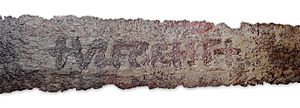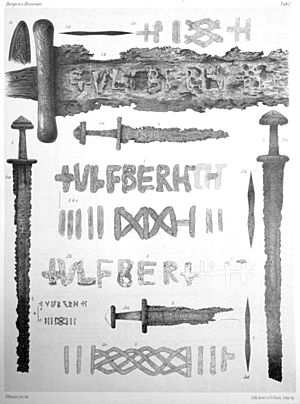Ulfberht swords facts for kids
Quick facts for kids Ulfberht swords |
|
|---|---|

The +VLFBEHT+ writing on a 9th-century sword blade. It was found in 1960 near Mannheim, Germany.
|
|
| Type | Sword |
| Production history | |
| Produced | 9th to 11th centuries |
| Specifications | |
| Mass | avg. 1.2 kg (2.7 lb) |
| Length | avg. 91 cm (36 in) |
| Width | 5 cm (2 in) |
|
|
|
| Blade type | Double-edged, straight bladed, slight taper |
| Hilt type | One-handed with pommel, variable guard |
| Head type | Acute distal taper, and point |
The Ulfberht swords are a special group of about 170 medieval swords. Most of them have been found in Northern Europe. These swords were made between the 9th and 11th centuries. Their blades are famous for having the inscription +VLFBERH+T or +VLFBERHT+ written into the metal.
The name "Ulfberht" is an old Frankish name. The Franks were a powerful group of people in Europe long ago. This name might tell us where these amazing sword blades were first made.
Contents
What Makes Ulfberht Swords Special?
These swords are a link between the older Viking swords and the knightly swords used in the Middle Ages. Most of them have a blade shape known as Oakeshott type X. This means they have a wide, flat blade that tapers slightly to a point.
Ulfberht swords were also among the first to have special writing on their blades. This started a tradition of adding inscriptions to swords. The back of many Ulfberht blades has a cool pattern, often like a braided design. Many other swords from this time also have these patterns, even if they don't say "Ulfberht."
These swords were made when most European swords were still "pattern welded." This means different types of metal were twisted and hammered together to make a strong, flexible blade. It looked a bit like "Damascus steel." But Ulfberht swords were special because some were made with very high-quality steel. This steel was possibly imported from faraway places like Central Asia.
Where Did Ulfberht Swords Come From?
Most experts believe Ulfberht swords were first made in the Rhineland area. This region is in what is now Germany. It was a central part of the Frankish kingdom, where the name "Ulfberht" was common.
Even though they were likely made in the Frankish lands, most Ulfberht swords have been found in Northern Europe. This might be because they were taken as loot during wars or traded. Back then, it was actually against the law in the Frankish kingdom to sell weapons to people from other countries.
Some Ulfberht swords have even been found as far away as Volga Bulgaria. This shows how far these special swords traveled along old trade routes.
How Many Ulfberht Swords Have Been Found?
In total, 167 Ulfberht swords have been discovered. Most of them were found in Scandinavia (like Norway and Sweden) and around the Baltic Sea. The exact number can be a bit tricky to count. This is because some swords are only small pieces, and some inscriptions might just be copies of the Ulfberht style, not true Ulfberht swords.
It's important to remember that finding many swords in Northern Europe doesn't mean they were used more there. In pagan (non-Christian) areas, people often buried warriors with their weapons. This means we find more swords in those places. In Christian areas, like much of continental Europe and England, burying weapons was not common. So, swords found there are usually just accidental discoveries, like in riverbeds.
This is why we don't find Ulfberht swords in Norway that are newer than the early 11th century. That's when pagan burial customs ended there.
| Country | Early Viking Age (8th - 9th ce.) | Middle Viking Age (10th ce.) | Late Viking Age (10th - 11th ce.) | Undated | Total |
|---|---|---|---|---|---|
| Norway | 17 | 19 | 5 | 3 | 44 |
| Sweden | 9 | 3 | 1 | 4 | 17 |
| Finland | 2 | 3 | 2 | 7 | 14 |
| Estonia | 2 | 3 | 1 | 3 | 9 |
| Latvia | 1 | 1 | 4 | 1 | 7 |
| Lithuania | - | 1 | - | 1 | 2 |
| Belarus | - | 1 | - | - | 1 |
| Ukraine | 1 | 5 | - | - | 6 |
| Russia | 4 | 5 | 1 | 1 | 11 |
| Russia (Kaliningrad Oblast) | 2 | 4 | 2 | 4 | 12 |
| Poland | - | 3 | 3 | 1 | 7 |
| Czechia | - | 1 | 1 | - | 2 |
| Croatia | 2 | - | - | - | 2 |
| Italy | - | - | - | 1 | 1 |
| Switzerland | - | - | 1 | - | 1 |
| Germany | 2 | 2 | 9 | - | 13 |
| Denmark | - | 3 | - | - | 3 |
| Netherlands | 2 | - | - | 1 | 3 |
| Belgium | - | - | 2 | - | 2 |
| England | 1 | 1 | 2 | - | 4 |
| Ireland | 2 | - | - | - | 2 |
| Iceland | - | 2 | - | - | 2 |
| Spain | - | - | 1 | - | 1 |
| France | - | - | 1 | - | 1 |
| Total | 47 | 57 | 36 | 27 | 167 |
When Were Ulfberht Swords Made?
The first Ulfberht swords were made in the 9th or 10th century. But swords with the Ulfberht name kept being made until the end of the Viking Age, around the 11th century.
One interesting sword found in Eastern Germany is from the 11th or early 12th century. It's special because it has the Vlfberht name and also a Christian inscription. This inscription says +IINIOMINEDMN, which means "in the name of the Lord." The name Wulfbert (another way to spell Ulfberht) was used from the 8th to 10th centuries.
See Also
 In Spanish: Espada Ulfberht para niños
In Spanish: Espada Ulfberht para niños
- Viking Age arms and armour
- Ingelrii, a similar inscription type
- Blade inscription



